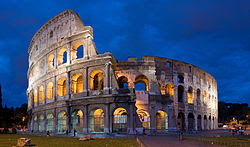The COLOSSEUM, also known as the Flavian Amphitheatre, is an oval amphitheatre in the centre of the city of Rome, Italy. Built of concrete and sand, it is the largest amphitheatre ever built. It is situated just east of the Roman Forum. Construction began under the emperor Vespasian in AD 72, and was completed in AD 80 under his successor and heir Titus. Further modifications were made during the reign of Domitian (81-96). These three emperors are known as the Flavian dynasty, and the amphitheatre was named in Latin for its association with their family name (Flavius).
The Colosseum could hold, it is estimated. between 50,000 and 80,000 spectators, having an average audience of some 65,000. It was used for gladiatorial contests and public spectacles such as mock sea battles (for only a short time as the hypogeum was soon filled in with mechanisms to support the other activities), animal hunts. executions re-encactments of famous battles, and dramas based on Classical mythology. The building ceased to be used for entertainment in the early medieval era. It was later re-used for such purposes as housing, workshops, quarters for a religious order, a fortress. a quarry and a Christian shrine.
Although partially ruined because of damage cause by earthquakes and stone robbers, the Colosseum is still an iconic symbol of Imperial Rome. It is one of Rome's most popular tourist attractions and has also links to the Roman Catholic Church, as each Good Friday the Pope leads a torchlit "Way of the Cross" procession that starts in the area around the Colosseum.
The Colosseum is also depicted on the Italian version of the five-cent euro coin.
The Colosseum underwent several radical changes of use during the medieval period. By the late 6th century a small chapel had been built into the structure of the amphitheatre, though this apparently did not confer any particular religious significance on the building as a whole. The arena was converted into a cemetery. The numerous vaulted spaces in the arcades under the seating were converted into housing and workshops, and are recorded as still being rented out as late as the 12th century. Around 1200 the Frangipani family took over the Colosseum and fortified it, apparently using it as a castle.
Severe damage was inflicted on the Colosseum by the great earthquake of 1348, causing the outer south side, lying on a less stable alluvial terrain, to collapse. Much of the tumbled stone was re-used to build palaces, churches, hospitals and other buildings elsewhere in Rome. A religious order moved into the northern third of the Colosseum in the mid-14th century and continued to inhabit it untiil as late as the early 19th century. The interior or the amphitheatre was extensively stripped of stone, which was re-used elsewhere, or 9in the case of the marble facade) was burned to make quicklime. The bronze clamps which held the stonework together were pried or hacked out of the walls, leaving numerous pockmarks which still scar the building today.
If you are interested, there is quite a lot more to be learned about the Colosseum on Wikipedia.



I love the Colosseum, just the way it looks is beautiful to me, especially when lit from inside as in your first picture there.
ReplyDeleteI didn't know this much about its history though, so thank you.
It certainly is a fascinating place and I'm glad I was able to enlighten you a little about its history. I too found it very interesting.
DeleteI am constantly amazed at what our distant ancestors could build. Without computers. Without electricity. And how very beautiful and long lasting so much of it has been.
ReplyDeleteSo true and one wonders if some of the monstrosities they build these days will last to the end of the millenium.
DeleteI feel there are very few true artisans in existence these days.
I wonder what we will leave behind? It's hard to imagine any of our modern buildings surviving as long as this one has.
ReplyDeleteAgreed Sandi. as I just said to EC (above). What will we leave behind?
DeleteNow I am imagining archealogists a thousand years from now excavating a Wal-mart:
Delete"This must have been some kind of temple!"
:) Oh, boy...
Very interesting! In my ignorance I just assumed the Colosseum had not been used since Roman times. Of course it makes sense that people would have made use of the structure throughout the ages.
ReplyDelete